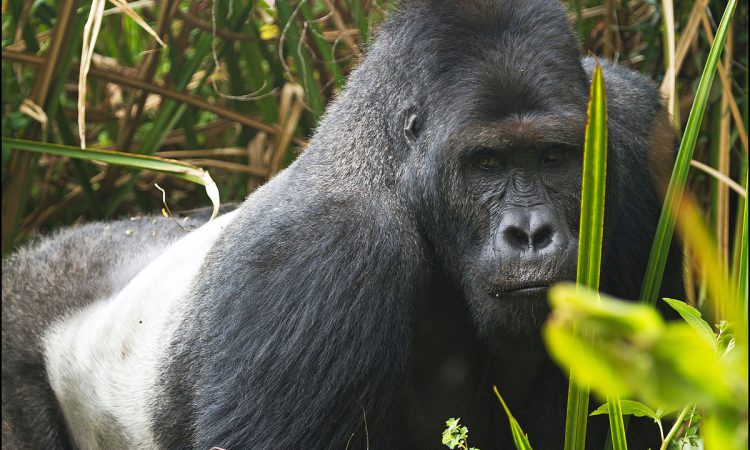Eastern Lowland Gorillas are the largest gorilla species in their subspecies. They have many similarities to humans such as fingerprints. Their population of about 6,500 individuals lives in the wilderness of D.R Congo. They are also known as Grauer’s gorilla, or Gorille de Grauer. Their scientific name is Gorilla beringei graueri. They are endemic to the moist Congo basin rain forests.
Location of Eastern Lowland Gorillas.
They are located in the eastern frontier of Democratic Republic of Congo, Central Africa. This area has vast lands covered with tropical rain forests.
Appearance of Eastern Lowland Gorillas
An eastern lowland gorilla is marked by short muzzle, large hands and an impressive stocky body. They have large thumbs and considerably smaller fingers. The male gorilla chests have no hairs compared to the rest of the body.
Scientific classification of Eastern Lowland Gorillas.
- Kingdom – Animalia
- Phylum – Chordata
- Class – Mammalia
- Order – Primates
- Family – Hominidae
- Genus – Gorilla
- Species – Gorilla beringei
- Subspecies – Gorilla beringei graueri.
Diet of Eastern Lowland Gorillas.
The Eastern lowland gorillas feed on leaves, tree stems, tree barks and succulent fruits. They also feed on termites and wandering ants. They are generally herbivores.
Weight and height Eastern Lowland Gorillas.
The average weight of Eastern lowland gorillas is averagely between 160 to 210 kilograms for males, and 80 to 150 kilograms for females. While standing, male gorilla’s height ranges between 5 to 7 feet. Females have a height of about 5.5 feet.
Genetic and family composition.
Eastern lowland gorillas are social primates. They live in family units too, just like mountain gorillas. Their families are headed by silverbacks, which are male mature gorillas. The other family members include young males known as black backs, females, and infants.
Different from the widely known narrative of aggressiveness in these apes, factually, Eastern lowland gorillas are generally rather timid creatures. Genetically, they have some close DNA similarly to that of human beings, although not so close as that of chimpanzees.
Eastern Lowland Gorilla Habitat
As their name suggests, they live in lowland areas, specifically in isolated tropical rainforests in the corridor of Virunga Mountains and Bukavu region in southern Kivu region.
Conservation status of Eastern Lowland Gorillas.
The Eastern lowland gorillas are critically endangered. There has been rapid shrinking of their breeding grounds due to uncontrolled human activity. The high poverty levels push humans into cutting down forest trees to get timber for sale and also firewood for domestic use. Another issue is the rapid resource exploitation.
D.R Congo is endowed with numerous natural resources like minerals, which to mine require clearing some of these forest lands to create space for mining activities. Poaching for meat and skins is another danger. Lastly, are the wars created by man. In D.R Congo, the Eastern regions are engulfed in constant wars by guerillas something that is disastrous to these gorillas.
Comparison with other species of gorillas like mountain gorillas.
These two species have numerous similarities, but differences alike. Their differences are in population, their habitats, and their physical appearances. Regarding the physical appearance, the mountain gorillas have a darker color compared to the Eastern lowland gorillas. The mountain gorilla’s hairs are thicker than those of the Eastern lowland gorillas. The Eastern lowland gorillas edge the mountain gorillas with their larger and broader chests, and longer faces. The Eastern lowland gorillas weigh much more than the mountain gorillas.
With regards to population, the Eastern lowland gorillas have an established population that almost triples that of the mountain gorillas. Whereas mountain gorillas are estimated at about 1,000 individuals, the Eastern lowland gorilla’s population is about 3,000 individuals.
The Eastern lowland gorillas can only be found in the lowland areas of Democratic Republic of the Congo, whereas the mountain gorillas inhabit the jungles of Rwanda, D.R Congo, and Uganda. The mountain gorillas are also more trekked than Eastern lowland gorillas, just because of the mountain gorillas’ multiple locations.
Trekking the Eastern lowland gorillas in D.R. Congo.
This species can be trekked in Maiko National Park, and the Kahuzi-Biega National Park. They can also be trekked in the Tayna Gorilla Reserve, the Itombwe Massif, and the expanse of Usala forest.
You can visit both the lowland and mountain gorillas species when in D.R. Congo.
Enjoy combined tours in both Rwanda and Congo.
Cost of trekking permits from Eastern lowland gorillas.
The trekking permit costs $400 for each foreign visitor. Each East African national pays $200 for the trekking permit, and D.R Congo citizens pay $20 for each individual.
Best time to trek Eastern lowland gorillas.
Given their location, Eastern lowland gorillas can best be trekked from late June to September. In the tropics, this is a dry season. The second such season is in the month of December to late February which is also a convenient period to engage in gorilla trek.
What to carry?
Backpack, a camera (however trekkers should note that flash cameras are prohibited), raincoat or jacket. Comfortable hiking wear, Snacks and water (water bottle), gardens gloves, boots. Insect repellents and Pair of binoculars.








